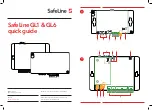
Page 5
© 2009 Active Research Limited
USG-1 solutions
Solution #1 - Ground loops
The first problem encountered when using a standard
USB to serial converter (or a standard RS232 port) is that
the ground of the PC is then shared with the NMEA 0183
system ground.
PCs are often powered from a mains inverter, generator
set or direct from mains supply when in dock, whereas the
marine electronics are normally connected to the current
marine battery set.
This means that when you connect the two systems
together, you are joining two different power systems. This
can result in no visible problems, but more often it results
in one of three consequences:
1. Data corruption - the data becomes garbled as the
electrical data signal now floats on a noisy ground
current flowing between the two power systems.
2. The PC crashes intermittently as ground currents
flow across its sensitive electronic circuitry. This can
cause permanent damage.
3. In the case of large ground loop faults, some
components can melt / catch fire / fuses blow or earth
leakage devices trip.
The
USG-1
solves all these problems by providing a safe,
opto-isolated barrier between the two systems.
Because
the signal travels across this barrier as light
, the signals
do not share the same ground, and safety is assured as
no current can flow between the two power systems. In
addition, a built-in power isolator completes the isolation.
Solution #2 - Different standards
PC serial or “COM” ports use the RS232 standard. This
uses a ground and a receive pin to get data from a
connected system. Data is sent as voltages referenced
to ground on a single transmit line. This type of drive is
known as “single-ended”.
In contrast, NMEA 0183 systems use a “differential”
system, where a “Positive” data line and a “Negative” data
line move in opposition to each other.
Many installations without isolated outputs have been seen
where the negative data line on a differential drive system
has been connected to the ground of the PC. If you’re
lucky, this may work, but if not, you will either simply get no
data, or at worst, damage your equipment.
The USG-1 solves this by using ingenious circuitry unique
to Actisense in both it’s “Listener” (receiver) circuit and
its ISO-Drive “Talker” (transmitter) circuit. These circuits
are compatible with both RS232 and NMEA 0183 types.
Please refer to the
more information on “Talkers” and “Listeners”.
Solution #3 - PC has no serial port
Many laptop and desktop PCs do not come equipped with
RS232 type serial ports any more. The USG-1 creates a
marine standard NMEA 0183 port from any PC USB port.
This port appears on the PC system as a regular “COM”
port, and so can be used with all standard navigation and
display software.
Features
Standard USB connection -
Equipped with a type “A”
USB connector to connect to a USB port or hub (USB v1.1
or v2.0 compliant).
ISO-Drive output technology
creates a driver, unique to
Actisense, that is isolated to 1500 volts - say goodbye to
ground loop issues!
ISO-Drive allows a completely “floating” output to be
created, making a safe connection to a PC an easy task.
You can use the ISO-Drive output to safely transfer data
to an NMEA 0183 device, or to another PC. The output
automatically changes between differential and single
ended drive depending upon the type of instrument it is
connected to.
NMEA 0183 OPTO input -
a floating receiver opto-isolated
to 2500 volts protects your system even during the most
extreme fault conditions.
This differential input is fully compliant with the NMEA 0183
standard specification. This allows the USG-1 to work
correctly with long cable runs and in a noisy environment.
Typical operating voltage is 2.0v to 15.0v. The unit can
wit/- 35v continuously, and +/- 40v transients. The
input is also compatible with RS232 signal levels.
The Opto-isolator can thus protect any upstream equipment
(chart plotter, laptop PC, radar etc.) from up to 2500v of
common mode voltage difference.
PC USB drivers supplied on disc
- the drivers allow the
USG-1 to appear as a standard “COM” port on the PC.
Low current consumption
- the USG-1 is powered
directly from the USB port on your PC, so no extra power
cables are required.
Tough Polycarbonate case
- certified to IP54 (Splash
and dust proof) when used with both supplied cables.
Software updates
The USG-1 has no built-in firmware, but Actisense will
be providing updates to the PC USB drivers free on
our website,
when they become
available.
Summary of Contents for USG-1-B-422
Page 2: ......


































